| |
 |
|
The Barbary
Wars
The Barbary Pirates were based in North Africa, and were
the scourge of both the Mediterranean and Atlantic seas. They were
active from shortly after the Christian conquest of Granada in 1492
until about 1830, when the pirates were finally brought under control
after repeated attacks from, and treaties with, various Western powers.
The 17th century, was the period during which the activities of the
Barbary Pirates reached their peak.
While the Barbary pirates were not averse to acquiring property, their
main focus was on capturing people - both on the sea and on land, to
sell as slaves. Historically, it is said that most of the Barbary
pirates were followers of Islam. Yet, a vast number of the pirates where
actually Christian renegades from England, Holland, and from throughout
Europe. Many of these Christian renegades started their careers as
privateers (basically pirates sanctioned by a government to prey upon
enemy vessels), before turning to unsanctioned piracy. Many of these
renegades eventually 'turned Turk' (i.e., converted to Islam) and went
a-pirating, more out of avarice and a sense of adventure than for any
religious or political purpose.
Slavery and the slave trade
saw primarily white Europeans being sold
into slavery in North Africa by the Barbary Pirates, at the same time
during which Europeans were capturing and enslaving Africans. |
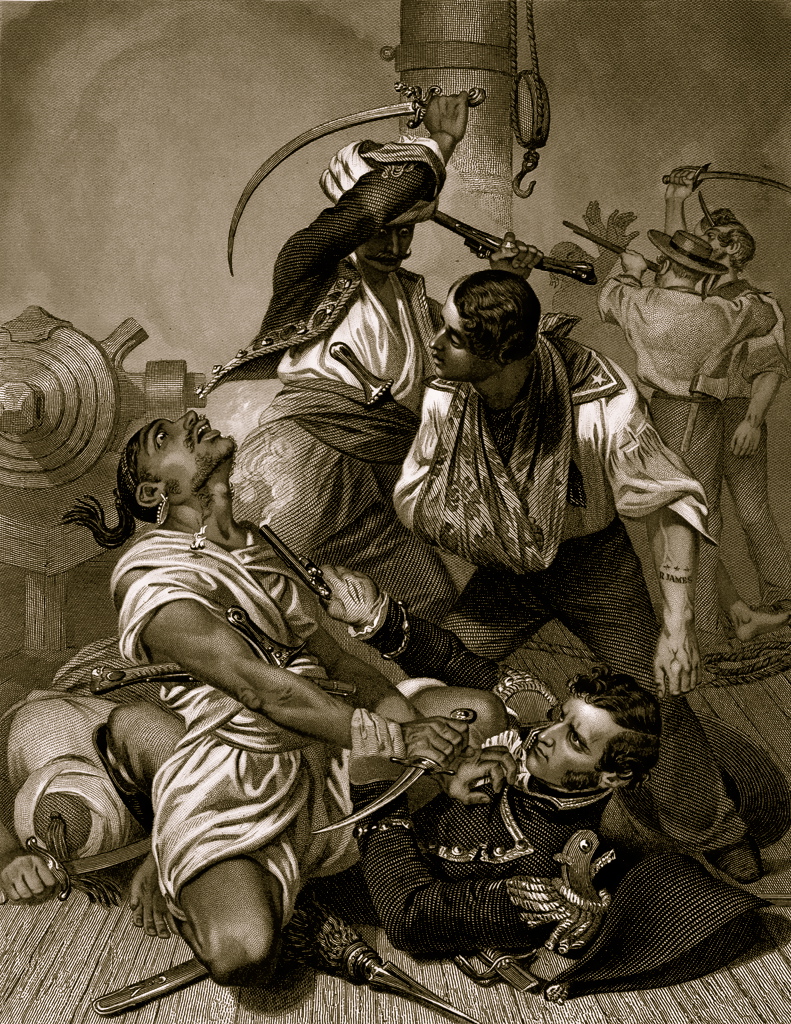 |
|
History of the Barbary Pirates
Admiral, naval hero, privateer, warrior and
empire-builder, Kheir ed-Din or Barbarossa, as he was known in the West,
was a legendary figure. He was born on the island of Midilli, Greece, to
a Turkish father and Greek mother. He rose to become High Admiral of the Ottoman Navy,
Sultan of Algiers and friend and advisor to Suleiman the Magnificent.
The term "Barbary" derives from Barbarossa (red beard) and refers to the
early days of Barbarossa’s career when he and his three
brothers turned privateers in the Mediterranean to counteract the privateering
Knights of St. John of the Island of Rhodes.
In February 1538, a Holy League comprising the Papacy in Rome, Spain,
the Holy Roman Empire Under Charles V, and the
Maltese Knights of St.
John of Jerusalem, arrayed themselves against the Ottomans. But
Barbarossa defeated its combined fleet, commanded by Andrea Doria, at
the Battle of Preveza in September 1538. This sea battle secured the
eastern Mediterranean for the Turks (until their defeat at the
Battle of
Lepanto in 1571). Thereafter, Barbarossa Hayreddin Pasha became one of
the great figures at the Court of Constantinople until his death on the
4th of July, 1546, at his palace in Istanbul. Turkish records recorded
'The King of the Sea is dead'.
The Barbary States was a collective name given to a
string of North African seaports stretching from Tangiers to Tripoli.
These ports were under the nominal control of the Ottoman Empire,
|
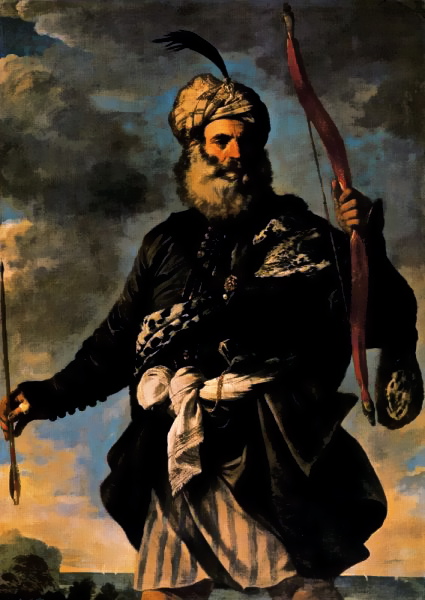
Barbary Pirate |
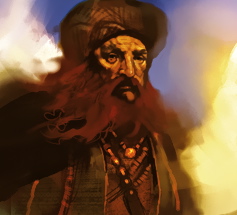
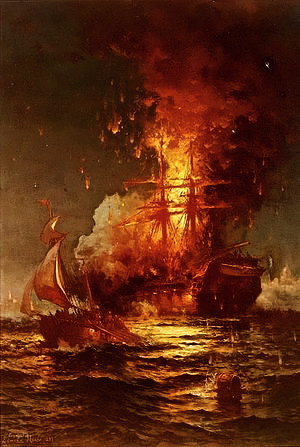
The
USS
Intrepid, loaded with explosive ordinance, and sailed by a crew of
volunteers into Tripoli`s harbor, was an incendiary ship, ordered to
burn the Barbary Fleet, but was instead destroyed by Tripoli's
cannons, and
exploded killing its entire crew.
|
but their real rulers were sea rovers or corsairs who sallied forth from the coast
cities to plunder Mediterranean shipping and capture slaves for labor or
ransom. By the middle of the seventeenth century, piracy along the
Barbary Coast had become a relatively easy, publicly acclaimed way of
making a living. The pirates were technically corsairs, who were given a
government license to steal, for piracy was profitable to the pashas who
ruled these coastal cities as independent and absolute monarchs. They
answered to no one and considered violence and piracy a tradition.
European nations chose to pay tribute to the Barbary Pirate
strongholds for their ships safe passage while traversing the
Mediterranean Sea. The focus being
always upon the gold and other fantastic profits of the Americas.
The tribute was mere pittance compared to the riches of the colonies.
The mighty British navy could easily have defeated the pirates.
During the colonial period, the British had also paid tribute for any |
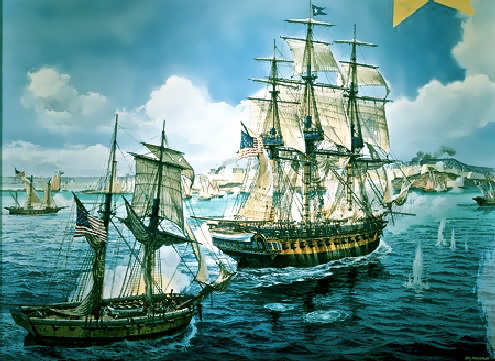
"Old Ironsides" August 3, 1804
Leading squadron in an attack on the pirate lair at Tripoli
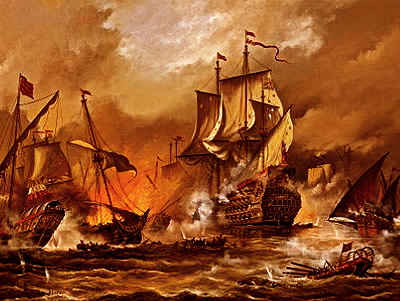 |
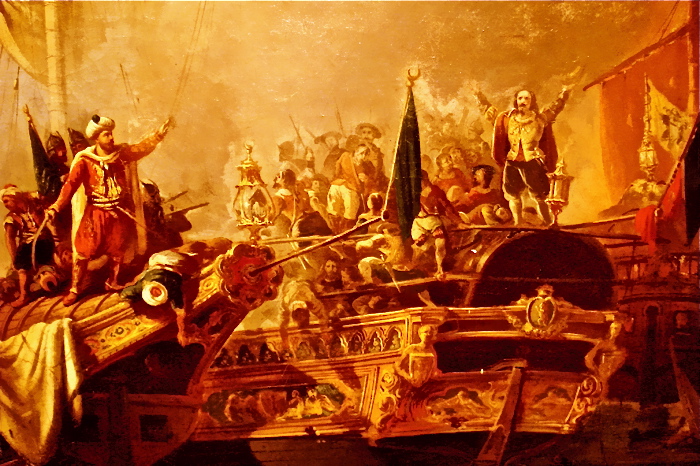
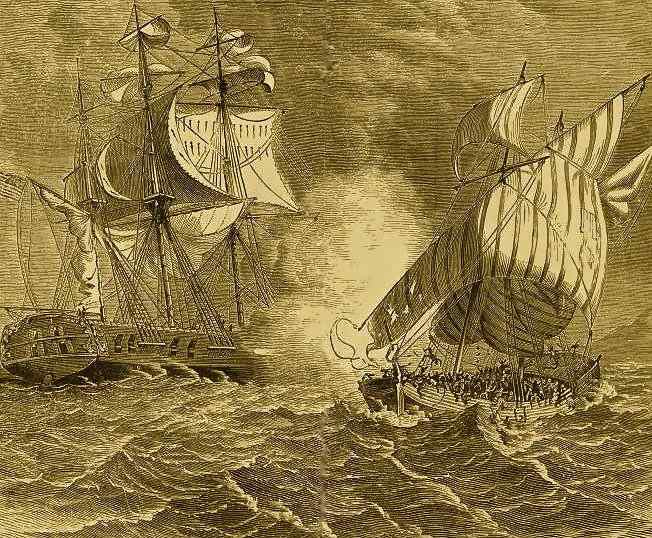 |
vessels from the colonies, and France had done
so during the American Revolution. By the time the United States
gained its independence in the late 1700s, the Barbary States had come
to regard the Mediterranean as their own private lake. It was a shock to
the newly independent United States when one day in 1785 an American
ship was seized and its crew jailed by a pirate ship in the employ of
Algiers.
The Barbary Pirates became the incentive for the newly created United
States to establish a navy in 1794. One of the six frigates built was
the USS Constitution, which is still in service today and puts to sea
upon occasion.
After ten years time and a hefty ransom of one million to recover some
of the poor souls taken captive, with all attempts at diplomacy
rejected, the United States refused to pay further extravagant tribute.
As a result, Yusuf Karamanli, the Pasha of Tripoli, declared war on the
US on May 10, 1801. To make his point, Yusuf had his soldiers chop down
the flagpole in front of the American consulate, which meant war.
Seven U.S. warships were sent to the Mediterranean and through 1803
the U.S. maintained a blockade of the Barbary ports and attacked Barbary
pirate ships. A turning point in the war came in 1805, at the
Battle of Derna, by a combined force of United States Marines
and Arab, Greek and Berber mercenaries. The Marines wore leather around
their necks as protection from sabers, leaving them with the name
leathernecks.
On June 10, 1805, Tripoli's pasha signed a treaty ending hostilities
with the United States.
In 1815, a Second Barbary War was waged against Tripoli, Tunis, and
Algeria known collectively as the Barbary states, after the Pasha of
Algiers had resumed attacks on American vessels and the seizure of
American sailors. The U.S. therefore responded by sending a naval fleet
back into the Mediterranean. The fleet, under the command of Steven
Decatur, captured several Algerian ships and forced the Pasha to sign a
treaty agreeing to return all captives and to cease attack on American
shipping. This marked the end of the Barbary domination of the
Mediterranean Sea. |
|
 |
|
 |
|
White Slaves of Barbary
Much attention and condemnation has been directed
towards the tragedy of the African slave trade, which took place between
the 16th and the 19th centuries. However, another equally despicable
trade in humans was taking place around the same time in the
Mediterranean. It is estimated that up to 1.25 million Europeans were
enslaved by the so-called Barbary corsairs, and their lives were just as
pitiful as their African counterparts. They have come to be known as the
white slaves of Barbary.
Slavery is one of the oldest trades known to man. We can first find
records of the slave trade dating back to The Code of Hammurabi in
Babylon in the 18th century BCE. People from virtually every major
culture, civilization, and religious background have made slaves of
their own and enslaved other peoples. |
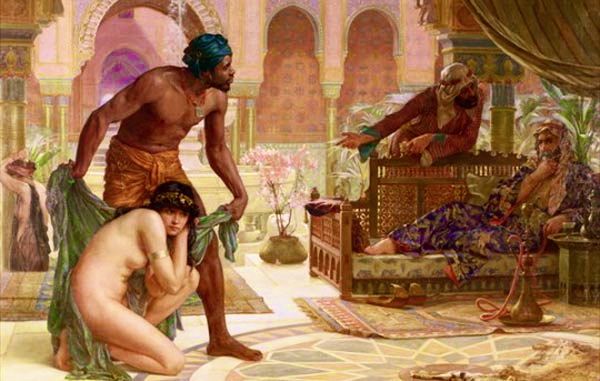 |
| However, comparatively little attention has been given to the
prolific slave trade that was carried out by pirates, or corsairs, along
the Barbary coast (as it was called by Europeans at the time), in what
is now Morocco, Algeria, Tunisia, and Libya, beginning around 1600 AD. |
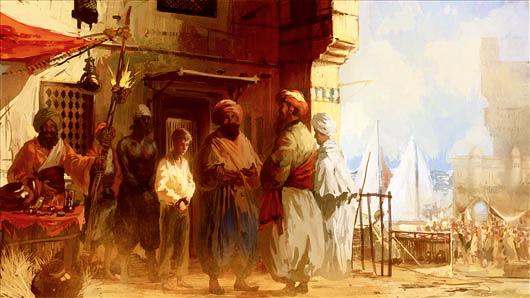 |
Anyone travelling in the Mediterranean at the time faced the real
prospect of being captured by the Corsairs and taken to Barbary Coast
cities and being sold as slaves.
However, not content with attacking ships and sailors, the corsairs also
sometimes raided coastal settlements in Italy, France, Spain, Portugal,
England, Ireland, and even as far away as the Netherlands and Iceland.
They landed on unguarded beaches, and crept up on villages in the dark
to capture their victims. Almost all the inhabitants of the village of
Baltimore, in Ireland, were taken in this way in 1631. As a result of
this threat, numerous coastal towns in the Mediterranean were almost
completely abandoned by their inhabitants until the 19th century. |
|
Captured Arrive on the Barbary Coast
to be Sold as Slaves |
In the 13th and 14th Centuries, it was Christian
Pirates |
| They were primarily from Catalonia and Sicily, and dominated the
seas, posing a constant threat to merchants. It was not until the
expansion of the Ottoman Empire in the 15th century that the Barbary
Corsairs started to become a menace to Christian shipping. |
|
Around 1600 AD, European Pirates brought advanced
sailing and shipbuilding techniques to the Barbary Coast, which enabled
the corsairs to extend their activities into the Atlantic Ocean, and the
impact of Barbary raids peaked in the early to mid-17th century.
While the Barbary slave trade is typically portrayed as Muslim
Corsairs capturing white Christian victims, this is far too
simplistic. In reality, the corsairs were not concerned with the race
or religious orientation of those they captured. Slaves in Barbary could
be black, brown or white, Catholic, Protestant, Orthodox, Jewish or
Muslim. And the corsairs were not only Muslim; English Privateers and
Dutch Captains also exploited the changing loyalties of an era in which
friends could become enemies and enemies friends with the stroke of a
pen.
In comments which may stoke controversy, historian
Robert Davis claims that white slavery had been minimized or ignored
because academics preferred to treat Europeans as evil colonialists
rather than as victims. |
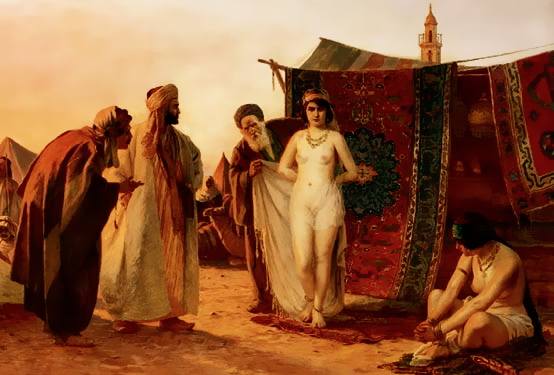 |
| "One
of the things that both the public and many scholars have tended to take
as given is that slavery was always racial in nature," said historian
Robert Davis,. "But that is not true," he added. |
|
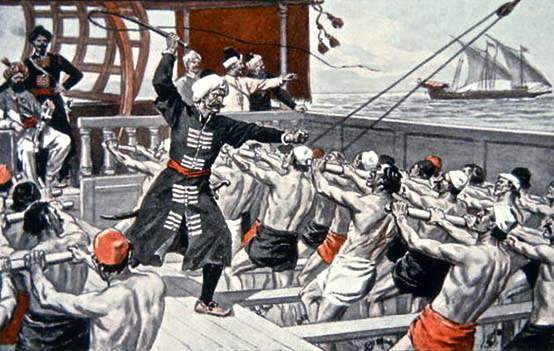 |
Life as a Barbary Slave
The slaves captured by the Barbary pirates faced a grim
future. Many died on the ships during the long voyage back to North
Africa due to disease or lack of food and water. Those who survived were
taken to slave markets where they would stand for hours while buyers
inspected them before they were sold at auction.
After purchase, slaves would be put to work in various
ways. Men were usually assigned to hard manual labour, such as working
in quarries or heavy construction, while women were used for housework
or in sexual servitude. At night the slaves were put into prisons
called 'bagnios' that were often hot and overcrowded. However, by far
the worst fate for a Barbary slave was being assigned to man the oars of
galleys. |
|
Galley Slaves of the Barbary
Corsairs |
Rowers were Shackled to the Seats |
| They never allowed to leave; sleeping, eating, defecation and
urination took place at the seat. Overseers would crack the whip over
the bare backs of any slaves considered not to be working hard enough. |
|
The End of the Barbary Corsairs
Corsair activity began to diminish in the latter part of
the 17th century, as the more powerful European navies started to force
the pirates to cease attacking their shipping. However, it wasn’t until
the first years of the 19th century, that the United States of America
and some European nations began to fight back more fervently against the
Barbary pirates.
Algiers was frequently bombarded by the French, Spanish and Americans,
in the early 19th century. Eventually, after an Anglo-Dutch raid in 1816
on Algiers, the corsairs were forced to agree to terms which included a
cessation of the practice of enslaving Christians, although slave
trading of non-Europeans was allowed to continue.
Occasional incidents continued to occur until another
British raid on Algiers in 1824, and finally, a French invasion of
Algiers in 1830, which placed it under colonial rule. Tunis was
similarly invaded by France in 1881. Tripoli returned to direct Ottoman
control in 1835, before finally falling into Italian hands in the 1911
Italo-Turkish War. The slave trade finally ceased on the Barbary coast
when European governments passed laws granting emancipation to slaves.
A Sea Fight with Barbary Corsairs . . . Circa 1681
(Photo Right) |
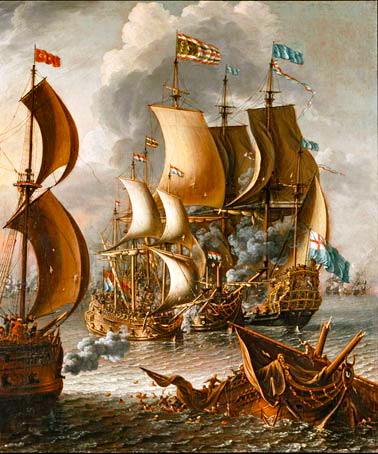 |
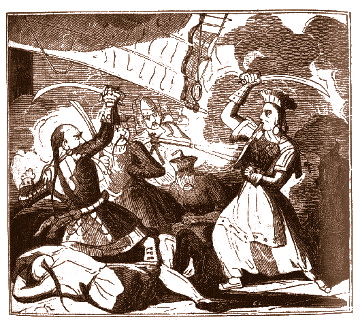 |
 |
|

Ching Shih (1775-1844)
translates “Widow of Zheng”. She was born Shih Yang (or Shi Xianggu) and
was a member of the Danjia (boat-dwelling) people of Guangdong (Canton)
Province. Nothing is known about her early life.
A prominent pirate from a family of pirates was Zheng
Yi. His family had been raiding and terrorizing the Chinese coast with
impunity since the mid-seventeenth century. During the late Ming era,
four prominent Danjia Clans; Shi, Ma, Zheng and Xu, dominated the piracy
trade at the mouth of the Pearl River.
In 1801, Shi Xianggu of the Shi clan married Zheng Yi of
the Zheng clan. Zheng was the leader of the Red Flag pirate fleet, and
Shi became known as Zheng Yi Sao (literally "wife of older brother Zheng
Yi"). They adopted a son named Chang Pao. First off, they
went to Annam (Vietnam) to fight in the Tay Son Rebellion. After
returning to Guangdong, China, they conducted joint operations with
another pirate, Wu Shi'er. |
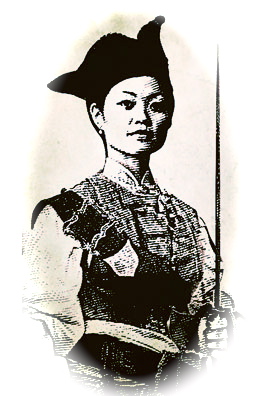 |
| The pair rapidly extended their scope of influence and eventually
established the Cantonese Pirate Coalition. Prior to forming the
coalition, the Zhengs already had 200 ships under their command. The
size of their fleet expanded to 600 ships after the coalition was
established. By 1806, virtually every Chinese vessel passing the coast
paid protection money. Their fleet ranged afield all the way from Korea
to Malaysia. |
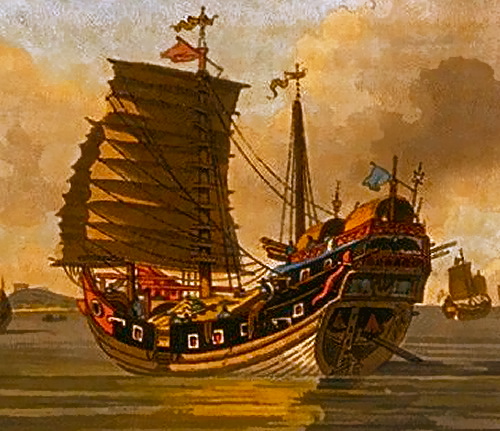
Chinese Junk |
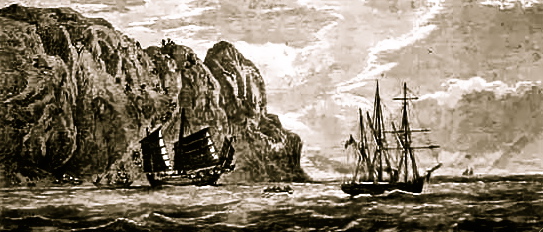
When Zheng Yi was put to his death in 1807 by a raging
Typhoon, Ching Shih took control of the fleet. The Red Flag Fleet was
then comprised of more than 1,200 ships, manned by 60,000 pirates, to
terrorize the South China Seas. The fleet was vicious and deadly, and
she was said to rule with an iron fist, imposing harsh punishments. |
| The Red Flag Fleet was one of the largest navies in the world and
nothing could stand against it. Ching Shih extorted tribute from
merchants all over the China Seas and from coastal towns from Macau to
Canton. She began to impose taxes and levies and enforced her own laws. |
Chinese naval forces attempted to end Ching Shih's reign, but her
massive pirate fleet kept defeating the Chinese ships in battle. When
forty ships were dispatched she sank all but 28, which she added to her
fleet. One admiral committed suicide to avoid being taken prisoner. The
Chinese navy couldn’t catch Ching Shih. British and Portuguese bounty
hunters were called in. They were mercilessly defeated.
Running out of options to stop Ching Shih’s reign of terror, the Chinese
government offered a truce in 1810. Ching Shih could keep her treasure
and would not be punished if she surrendered. She agreed to the terms,
and most of her pirates were given the same deal. Out of all her men,
only 126 were executed. The rest were given government jobs or military
positions. Some people believe that Ching Shih was part of a powerful
family that actually controlled the government, but this has never been
confirmed.
When the Opium War broke out, Ching Shih, now in her sixties, was still
active in resistance fighting against the British, helping Lin Zexu with
his battle plans. |
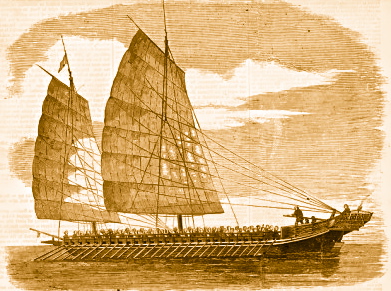
Chinese Pirates Canton |
| In retirement, Ching Shih remarried and had children. When her new
husband died in 1822, she moved back to Canton and opened a combination
casino and brothel which she operated until her death at the age of 69,
cause unknown. |
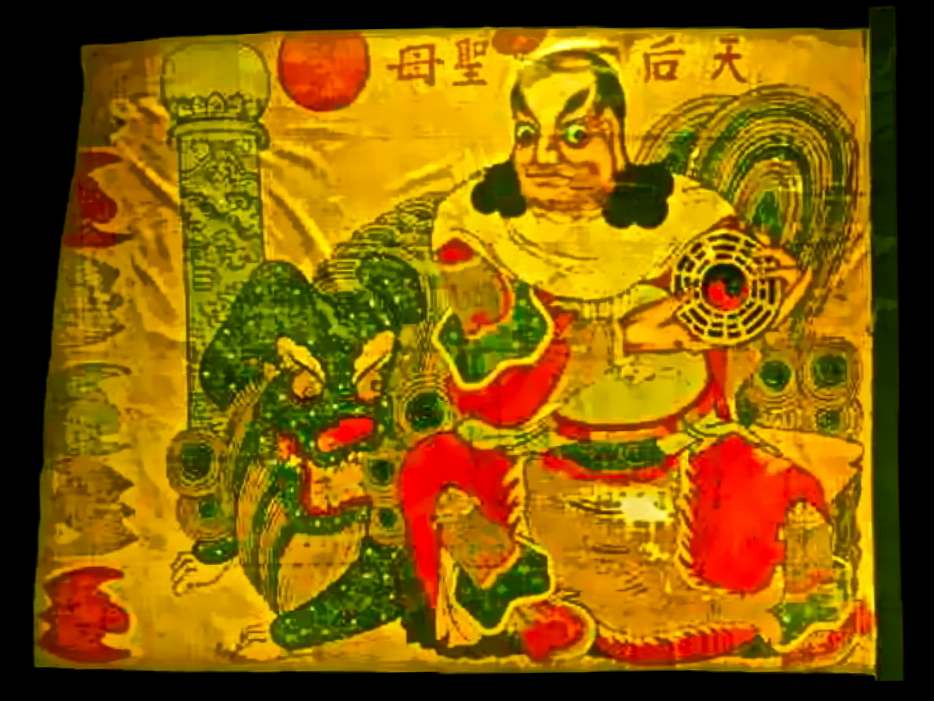 |
 |
|
I Sailed with Chinese Pirates
by Aleko E. Lilius
Book Review
"Yo ho ho and a bottle of Maotai! Lilius's forgotten
classic reads as boldly and bloodily as a Chinese 'Treasure Island'.
What is perhaps most remarkable about this extraordinary piece of
journalism is that the writer lived to tell the tale."
Adam Williams author of The Dragon's Tail
It is 1930 and piracy is rampant on the South China seas. Murderous
bands of cutthroats roam the Pearl River Delta and coastal shipping
routes, an ever-present menace to the trade of Hong Kong and beyond.
Globetrotting journalist Aleko E. Lilius sets out to infiltrate these
mysterious pirate gangs and is eventually taken into the confidence of
South China’s notorious pirate queen, Lai Choi San. Lilius lives, eats,
sleeps and of course sails with the pirates, witnessing their harrowing
misdeeds and delivering a sensational, rollicking tale of adventure.
Who is Aleko E. Lilius?
Aleko E. Lilius (1890-1977) was a journalist, writer of fiction and
adventurer born in St. Petersburg in 1890. Constantly on the move, his
flair for the exotic led him to explore Asia, North Africa and Mexico.
He is best known for his thrilling exploits with the Pirate Queen of
South China in I Sailed with Chinese Pirates and the Smuggling Queen of
Tangiers in Turbulent Tangiers. Lilius spent much of his later life in
America before retiring to Finland to paint. |
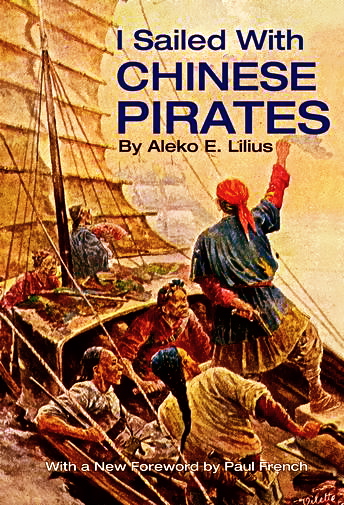 |
|
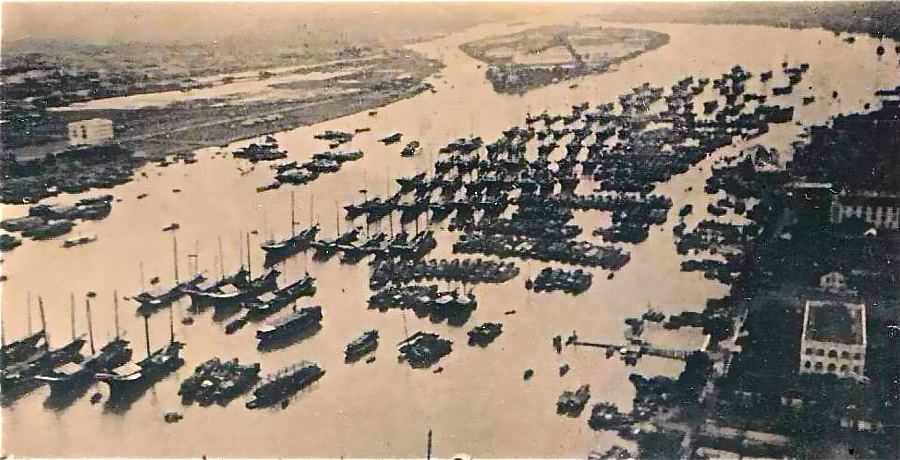
Pearl River - Canton |
Journalist Aleko E. Lilius came to the Far East seeking adventures
to write about. He found them, and published lurid accounts of piracy
and murder that became his 1930 best seller I Sailed with Chinese
Pirates.
In many ways Lilius was an old-school foreign correspondent; ranging far
and wide and often out of touch for months on end, leaving his editors
tearing their hair out and his audience anticipating his next adventure.
Then he would suddenly reappear in one fantastical and thrilling
situation after another. Most of the 1920s and 1930s found Lilius
roaming around North Africa, Asia and Mexico. In Mexico he was the
photographer accompanying the linguist Rudolf Schuller investigating
American-Indian languages and dialects; then he appeared in Morocco
among the souks and bazaars; then in China sailing with pirates and
lodging in opium dens. |
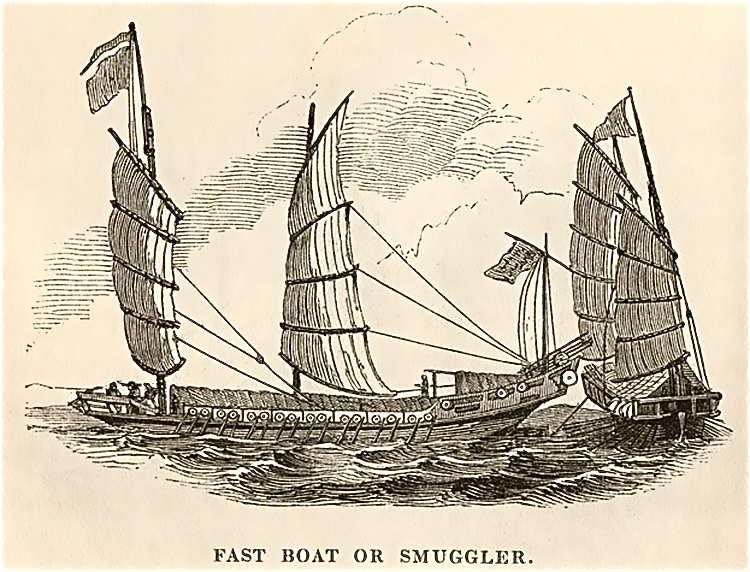 |
While researching I Sailed with Chinese Pirates, Lilius lived much
of the time in the Philippines, using his home in Zamboanga as a base to
explore the South China Sea region.
In 1931 the New York Times reviewed
the book:
A meeting with a mysterious woman pirate chief, Lai Choi San, with
several thousand ruthless buccaneers under command, is described in the
volume I Sailed With Chinese Pirates, which is published today by D.
Appleton & Co. Aleko E. Lilius, English journalist, while traveling in
the Orient, according to the publishers, succeeded in winning the
confidence of this unusual woman, and he accompanied her and some of her
desperadoes on one of their expeditions on a junk equipped with cannon.
Mr. Lilius's publishers describe him as the only white man who has ever
sailed with these pirates...
Lilius provided graphic portraits of the cut-throat pirates and
readers were especially thrilled by the idea of Lai Choi San, the female
pirate queen. |
|
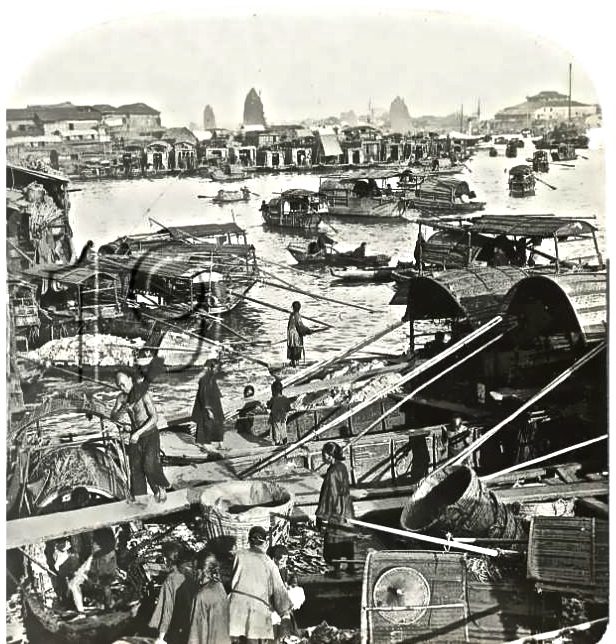
Canton Docks - Loading River Boat |
| I Sailed with Chinese Pirates is a useful history of the
period and the lawlessness of the southern China coast in the 1920s, but
above all Aleko Lilius's book is an adventure with a capital A. There
are facts and eye-witness accounts for the historian but for the casual
reader he hits all the notes required to ensure a bestseller — opium
dens, casinos with endless games of fan-tan, cutlass-wielding pirates
and real Spanish doubloons recovered from sunken treasure. Lilius
himself described I Sailed with Chinese Pirates as "a page from the Book
of Almost Unbelievable Adventures". It's as thrilling now as it was to
his readership in 1931. |
| It should also be noted that Lilius isn't exaggerating
the threat of piracy in the South China Sea and particularly around Hong
Kong and southern China in the 1920s. The area was indeed infested with
pirates who menaced both commercial and passenger shipping as well as
vulnerable coastal communities. Lilius provides us with a detailed list
of ships attacked during the 1920s to prove the point (Photo Right).
Excerpt from "I Sailed with Chinese Pirates", Chapter
One
by Aleko E. Lilius
It happened that she was going in the direction of Bias
Bay, she said, and she was willing to take me there and bring me back.
But there would be some delay, for she had business to transact on the
way — very serious business. The delay, however, would be insignificant,
she explained. Then as an afterthought, did I know that the trip would
be rather dangerous?
"Dangerous? Why?"
She smiled, but did not answer.
* * * * *
Here was I, an American journalist, getting the chance of a lifetime, to
sail with Chinese pirates to the central nest of the most merciless gang
of high-seas robbers in the world, in an armoured junk commanded by a
female pirate. Small wonder that I could hardly believe in my luck. What
a woman she was! Rather slender and short, her hair jet black, with jade
pins gleaming in the knot at the neck, her ear-rings and bracelets of
the same precious apple-green stone. She was exquisitely dressed in a
white satin robe fastened with green jade buttons, and green silk
slippers. She wore a few plain gold rings on her left hand; her right
hand was unadorned. Her face and dark eyes were intelligent — not too
Chinese, although purely Mongolian, of course — and rather hard. She was
probably not yet forty. |
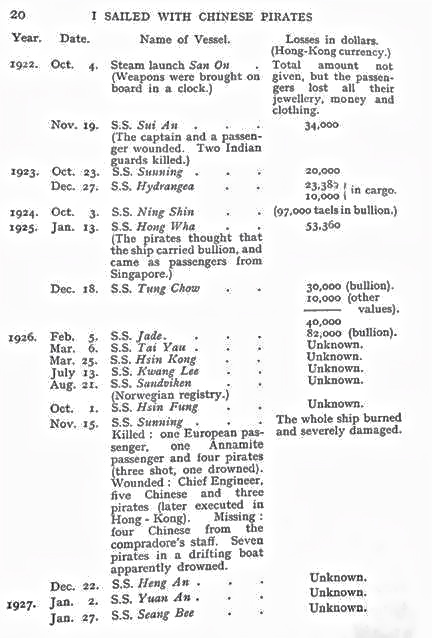 |
Every move she made and every word she spoke told plainly that she
expected to be obeyed, and as I had occasion to learn later, she was
obeyed.
What a character she must be! What a wealth of material for a novelist
or journalist! Merely to write her biography would be to produce a tale
of adventure such as few people dream of. |
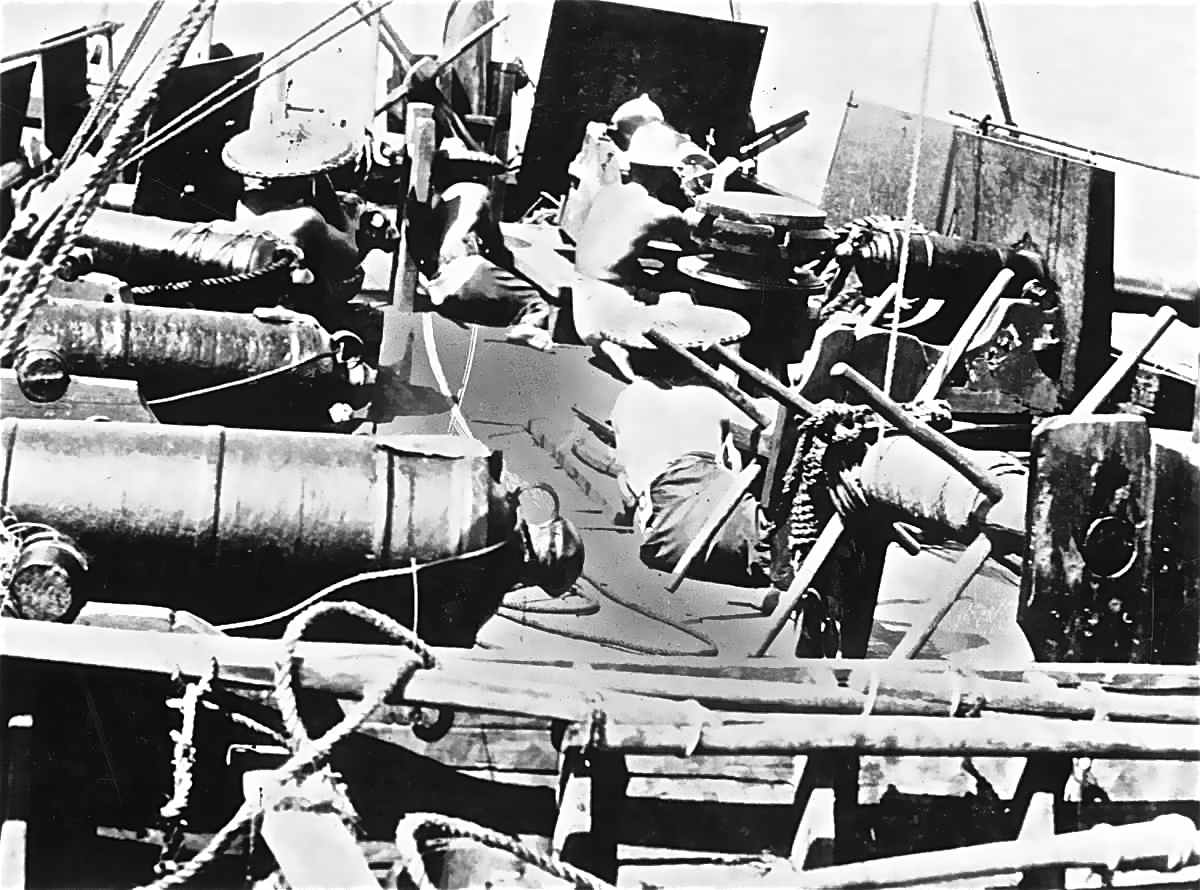
Chinese Pirate Ship Deck - Circa 1930's |
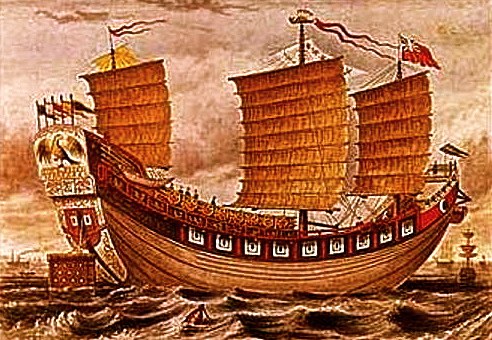
A junk is a Chinese sailing vessel.
The English name comes from Malay. Junks were originally developed
during the Han Dynasty (220 BC-200 AD) and further evolved to represent
one of the most successful ship types in history |
|
That evening I heard from an American who had sailed the
waters around Macao for fifteen years, the following story, about this
remarkable woman.
"Her name is Lai Choi San," he began, "So many stories centre
about her that it is almost impossible to tell where truth ends and
legend begins. As a matter of fact, she might be described as a female
Chinese version of Robin Hood. They have much in common. Undoubtedly she
is the Queen of the Macao pirates. I have never seen her. I have almost
doubted her existence until you told me of meeting her. She is said to
have inherited the business and the ships from her father, after the old
man had gone to his ancestors 'with his slippers on' during a glorious
fight between his men and a rival gang. The authorities had given him
some sort of refuge here in Macao, with the secret understanding that he
and his gang should protect the colony's enormous fishing fleets and do
general police duty on the high seas. He even obtained the title of
Inspector from somebody in authority, and that, of course, placed him
morally far above the other pirate gangs."
"He owned seven fully-armored junks when he died. To-day Lai Choi San
owns twelve junks; nobody seems to know how or when she acquired the
additional five, but it is certain that she has them. She has barrels of
money, and her will is law."
"You may ask," he continued, "why I call them pirates, since their job
is only to 'guard' the numerous fishing craft. However, the other gangs
want the same privileges as the present 'inspectors' have, therefore
they harass and plunder any ship or village they can lay their hands
upon. They kidnap men, women and children, hold them for ransom, ransack
their homes, and burn their junks and sampans. It is up to the
protectors to undo the work of these others and to avenge any wrong done
them. Naturally, there is bitter and continuous warfare between these
gangs."
"This avenging business is where the piratical characteristics of the
'protectors' come in. There is frequent and profitable avenging going on
wherever the various gangs meet. Lai Choi San is supposed to be
the worst of them all; she is said to be both ruthless and cruel. When
her ships are merely doing patrol duty she does not bother to accompany
them, but when she goes out 'on business' she attends to it personally.
When she climbs aboard any of her ships there is an ill-wind blowing for
someone."
|
|
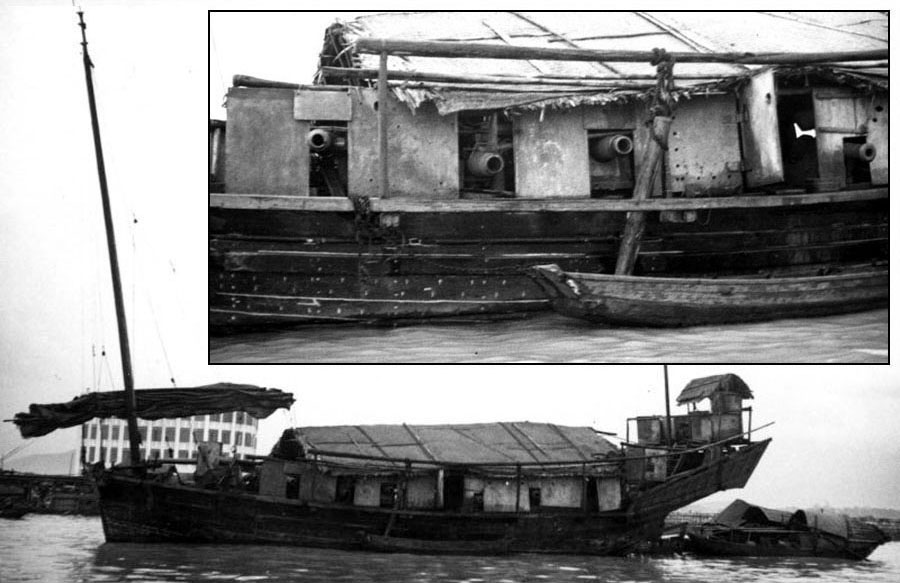
Chinese Pirate Gun Boat - 1931 |
An orange-colorred haze hung over the hills of Lappa. Slowly the
brown sails of our ship crept up, while the barefooted crew scurried
back and forth upon the decks. Finally the junk was clear to heave away.
On a nearby junk a Taoist priest in demon-red robes kowtowed and burned
fire crackers to his special deity in order to drive away the evil
spirits — all this for a few cents silver. I was dazed! It was difficult
to believe in my luck. |
At last I was actually tramping the deck of an honest-to-goodness
pirate ship! Our junk lay hidden among many other similar craft. It
would have been impossible to pick it out from the shore, and I wondered
how the captain would maneuver us out from such a crowded jumble of
boats. But I did not remain in ignorance long. Members of the crew
lowered a dinghy, rowed out some distance, and dropped an anchor. Then
the dinghy returned, and all hands hauled upon the anchor line until the
junk began to move slowly forward. Then the maneuver was repeated until
we had worked ourselves out into the open water. Hardly a sound was to
be heard on board-only the shuffling feet of the crew.
I took a look at the crew. Here in South China I had been used to small,
narrow-chested, almost effeminate men; but these fellows were almost
giants — muscular, heavy-chested, half-naked, hard-looking-real — bandit
types. Some of them wore the wide-brimmed hat such as one sees all over
Southern China. Some had tied red kerchiefs around their heads and
necks. |
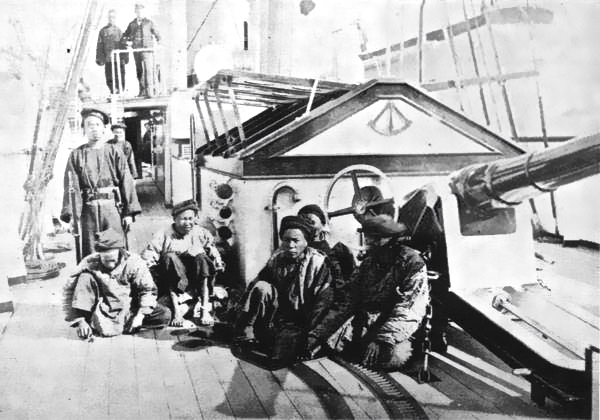
Captured Pirates - Circa 1930's |
| There was nothing for me to do but climb up on the poop and make
myself as inconspicuous as possible. I felt in the mood to do just that
too—a white man, an intruder, searching for unusual "copy." What right,
after all, had I to pry into their secrets? I was not a Secret Service
man, nor a government employee... |
|
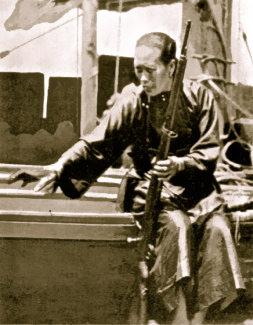
Chinese Pirate |
After publishing "I Sailed with
Chinese Pirates" Lilius later went on to other parts of the world
and to other thrilling adventures and remained popular with readers.
His 1956 book Turbulent Tangier, an account of the chaos of post-war
Tangiers featuring gold traffickers, the Smuggler Queen of Tangiers
and the last days of French rule, sold well but it was "I Sailed
with Chinese Pirates" that remains his best-known tale of adventure.
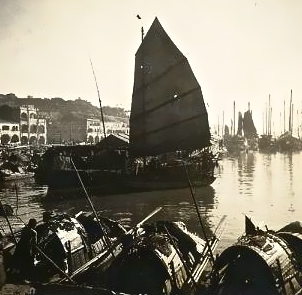 |
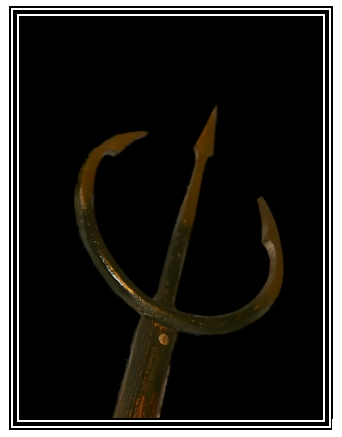
Chinese Pirate Trident |
|
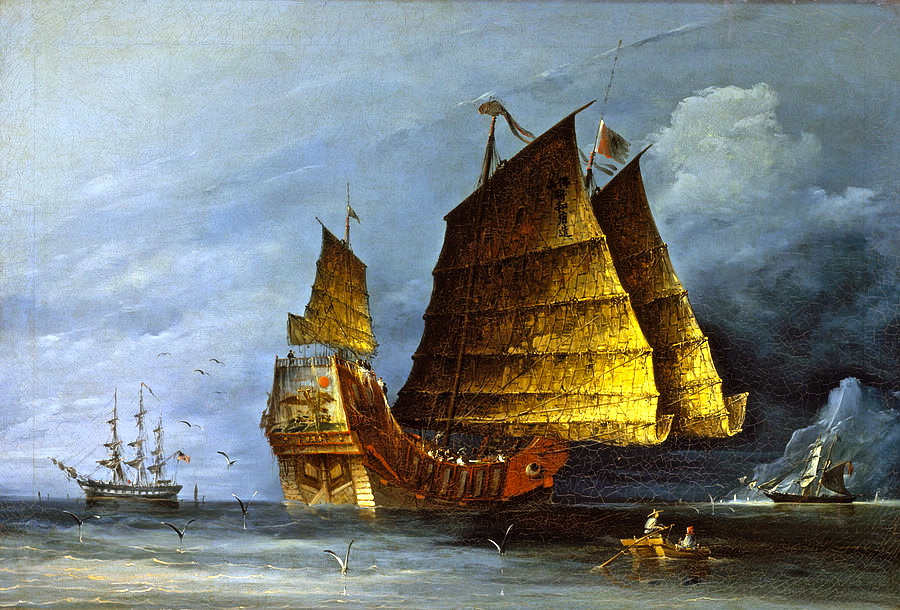
Red Hand Ship |
|
Angry Pirates Proliferate
|
|
The piracy business has changed a lot since 2010,
when it had reached levels of activity not seen in over a century. But
over the next three years that all changed. By 2013 attacks on ships by
Somali pirates had declined 95 percent from the 2010 peak. It’s been
over two years since the Somali pirates captured a large commercial
ship, and even smaller fishing ships and dhows (small local cargo ships
of traditional construction) are harder for them to grab. The rapid
collapse of the Somali pirates since 2010 was no accident. It was all a
matter of organization, international cooperation and innovation. This
came to consist of over two dozen warships and several dozen manned and
unmanned aircraft, as well as support from space satellites and major
intelligence and police agencies. |
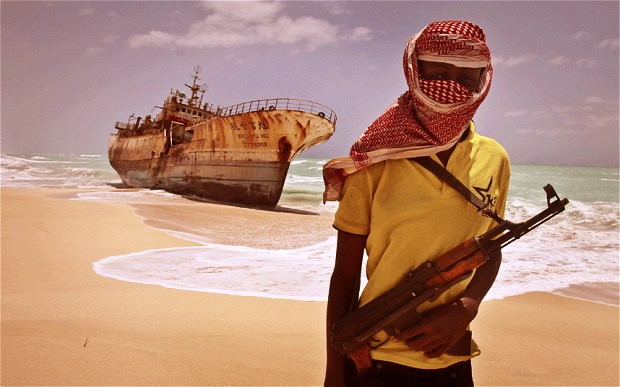 |
Back in 2010 the Somali pirates got most of the
publicity but they only carried out 44 percent of the attacks. What was
newsworthy was that the Somalis accounted for 90 percent of the
hijackings, and some 80 percent of the piracy was in and around the
Indian Ocean. Some 44 percent of all attacks involved the pirates
boarding the ships, while in 18 percent the pirates just fired on ships,
without getting aboard. There are still pirates out there, but they are
more into robbery than kidnapping.
The trend, was definitely up for two decades, with
the big increase coming in the last decade
|
1991: About 120 known
cases of real or attempted piracy
1994: over 200 cases
2000: 471 cases
2005: 359 cases
2010: over 400 cases |
|
| Piracy hit a trough from the late nineteenth century into the later
twentieth. That was because the Great Powers had pretty much divided up
the whole planet, and policed it. The pirates had no place to hide.
Piracy began to revive in a modest way beginning in the 1970s, with the
collapse of many post-colonial regimes. Note that what constitutes an
act of piracy is often not clearly defined. What most people agree on is
that piracy is non-state sanctioned use of force at sea or from the sea.
This could include intercepting a speedboat to rob the passengers, but
that's usually just thought of as armed robbery. And something like the
seizure of the Achille Lauro in 1985 is considered terrorism, rather
than piracy. In the past, some marginal states have sanctioned piratical
operations, like the Barbary States, but that is rare today. |
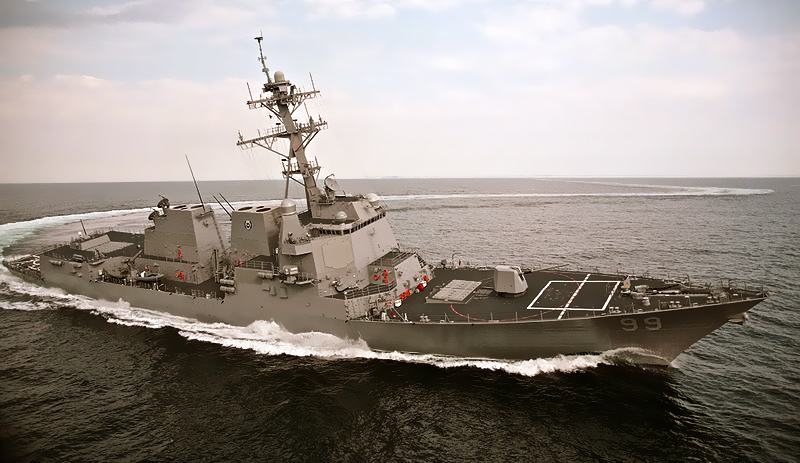 |
Pirates usually function on the margins of society,
trying to get a cut of the good life in situations where there aren't
many options. This is usually in areas where state control is weakest or
absent, in failing and "flailed" states. A flailing state is something
like Nigeria, Indonesia, or the Philippines, where the government is
managing to keep things together but is faced with serious problems with
areas that are sometimes out of control. In a failed state like, where
there isn't a government at all, pirates can do whatever they want.
The solution to piracy is essentially on land; go into uncontrolled
areas and institute governance. This has been the best approach since
the Romans eliminated piracy in the Mediterranean over 2,000 years ago.
Trying to tackle piracy on the maritime end can reduce the incidence of
piracy, but can't eliminate it because the pirates still have a safe
base on land. |
| In the modern world the "land" solution often can't be implemented.
Who wants to put enough troops into Somalia to eliminate piracy? And
flailing states are likely to be very sensitive about their sovereignty
if you offer to help them control marginal areas. But while there have
been far fewer attacks off Somalia there has been a big jump in attacks
in the Straits of Malacca (sevenfold increase since 2009) and off
Nigeria (a similar increase). The big difference is that only off
Somalia could ships and crews be taken and held for ransom for long
periods. Everywhere else the pirates were usually only interested in
robbing the crew and stealing anything portable that they could get into
their small boats. Off the Nigerian coast pirates sometimes take some
ship officers with them to hold for ransom or force the crew to move
small tankers to remote locations where most of the cargo (of oil) can
be transferred to another ship and sold on the black market.
Meanwhile there are two areas where pirates still thrive. Piracy in the
vital (most of the world's oil exports pass through here) Straits of
Malacca was largely an Indonesian phenomenon. It bothered the
Singaporeans a lot, the Malaysians a little, and the Indonesians not
much. But as Indonesia began stabilizing itself over the past decade
(the 2004 Aceh Peace settlement, the institution of a more democratic
government, defeating Islamic terrorism), the rate of piracy declined.
This decline was facilitated by the combined police effort of Singapore,
Malaysia, and Indonesia itself, which didn't come about until a lot of
issues among the three states were resolved. Neither Indonesia nor
Malaysia were all that upset about smuggling, which bothered Singapore.
Indonesia and Singapore still have some problems, as Singapore more or
less encourages sand stealing in enormous volumes from Indonesia. Since
2010 there has been an increase in piracy off Indonesia, largely because
the Indonesians reduced their anti-piracy patrols without warning or
explanation. There are lots of targets, with over 50,000 large ships
moving through the Straits of Malacca each year. That’s 120-150 a day.
Lots of targets. The shallow and tricky waters in the strait forces the
big ships to go slow enough (under 30 kilometers an hour) for speed
boats to catch them.
There are some regional constraints on piracy. There seems to be little
or no piracy in the Red Sea and Bab al-Mandeb. Apparently this was
because the smugglers decided the pirates interfered with their business
(by bringing in coalition naval forces), and so shut down any pirate
operations themselves.
The Gulf of Guinea has become another hot spot for modern (non
ship-napping) piracy. Nigeria is badly run and most of the oil revenue
is stolen by corrupt officials, leaving people living in the oil
producing areas near the coast very angry. More piracy has been one
result of all that anger. |
|
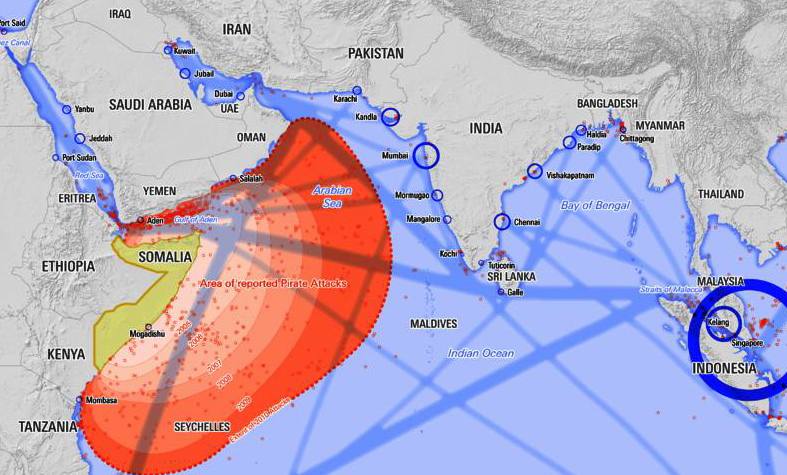 |
|
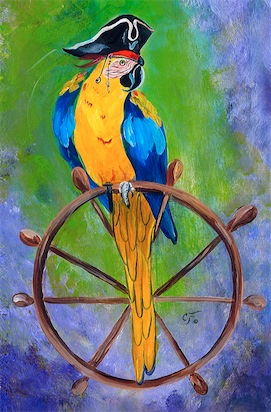 |
 |
| The Golden Age of Piracy - A period lasting from, in the
broadest sense, the mid-1600s through around 1730, encompassed a few
different major geopolitical and economic movements that created a space
for pirates. For one, the discovery of the Americas and Australia led to
a boom in exploration, which in turn led to an absurd amount of money
and valuables being ferried across oceans. Money, gold, slaves, spices,
and other highly prized goods (“goods,” in the case of slaves) traveled
back and forth. They were comparatively unprotected, the vastness of the
oceans and the miserable conditions of trans-oceanic journeys leaving
them weak and vulnerable. And many former sailors, with deep knowledge
of the sea, wondered why they should bother the difficult slog of
ferrying goods when they could simply steal them. And so came the
pirates. |
|
The Pirate Parrot is almost
certainly 'Grounded in Reality' |
|
Long John Silver |
Treasure Island by Robert Louis Stevenson |
Since Long John Silver - Clomped around on a wooden leg with
a parrot on his shoulder, the literary and pop-culture conception of
pirates has involved the parrot.
Long John Silver - Was the star of Robert Louis Stevenson’s
"Treasure Island". Long John was the first major fictional pirate
character to walk around with a pet parrot. This was based on real
truths. And the reasons why the parrot became associated with pirates
gives us a pretty good glimpse at the true-life existence of a pirate. |
Pirates - Depending as they did on robbing ships, mostly had
to go where the ships were. They followed trade routes, which means they
ended up in specific places; you didn’t see pirates flocking to deep
South America or anywhere in the Pacific Ocean. They stayed with the
ships, and ended up largely in the Caribbean, West Africa, and the
Indian Ocean’s coasts.
On long trips, whether conducted legally or illegally, pets were desired
but would need careful vetting. These long voyages, remember, could last
weeks or months, and mostly, they were incredibly boring and
uncomfortable. A companion animal could help ease the way. What kind?
Any large pet would be difficult to keep on a seagoing vessel, but cats
might very much be prized for their ability to catch vermin like rats in
the holds, etc of a vessel. Never any references in documents to dogs.
Dogs as pets was more of an aristocratic thing in the early modern
period.Pirates were traveling to exotic lands, had quite a bit of
free time, had disposable income, and thus had no particular reason to
restrict themselves to ordinary European pets like cats and dogs.
Monkeys were not uncommon, and the concept of a pet monkey made its way
into fiction as well. |
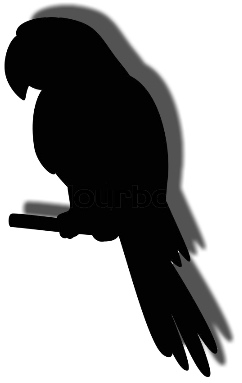 |
| A parrot was more sensible. They don’t eat much, compared to a dog
or a monkey, and what they do eat (seeds, fruits, nuts) can be easily
stored on board. They’re colorful, and intelligent, and funny, and for a
pirate (or a legal sailor) wanting to show off in port, a parrot would
do nicely. |
|
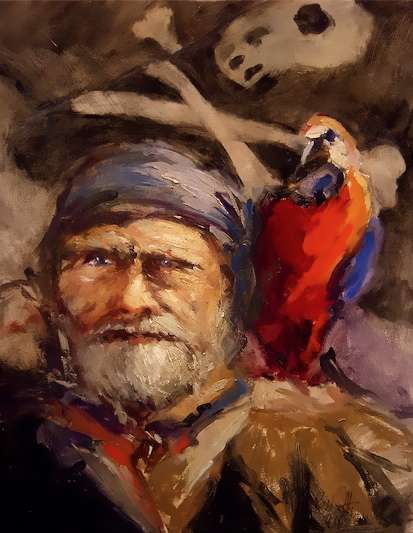 |
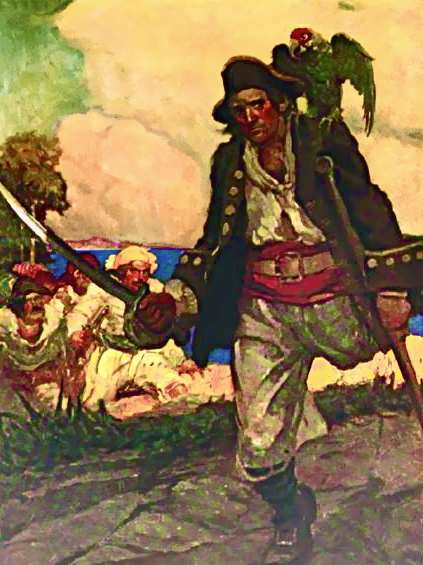 |
|
 |
Parrots - Would have been part of the exotic pet trade. Back
home people would pay good money for parrots and other exotic creatures,
and sailors could easily buy them in many Caribbean ports. Some were
kept, but most were sold, when the ship reached home. They were
colorful, they could be taught to talk. They were always entertaining
and they fetched a good price in the bird markets of London.
It might be tricky for a pirate to legally sell anything, especially an
attention-grabbing item like a parrot from the New World. Cities like
Boston and Charleston, where a parrot might be sold, were much smaller
in those days, and pirates were often well-known and hunted criminals
who would have a hard time entering the waterways of more populous
cities like London.
Early 18th Century - William Dampier, a British explorer, noted
that the best parrots came from near Vera Cruz, a coastal region of
Mexico. Pirates may have changed but humans have not. Vera Cruz remains
a hotspot for the illegal parrot trade, a place where thousands are
illegally poached each year.
 |
|
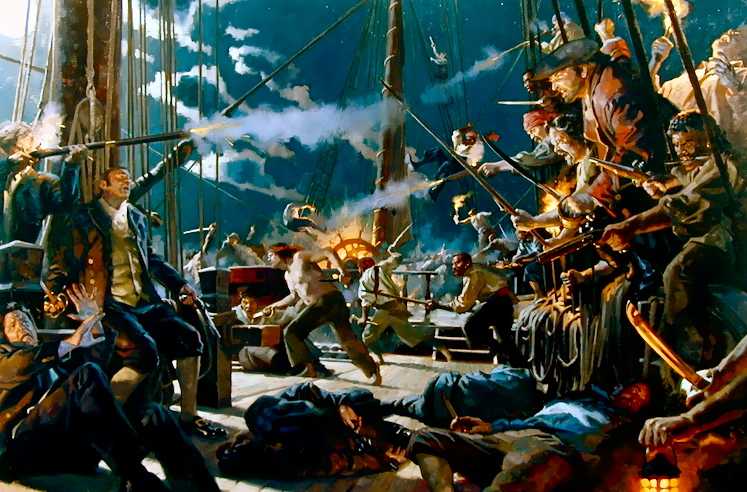 |
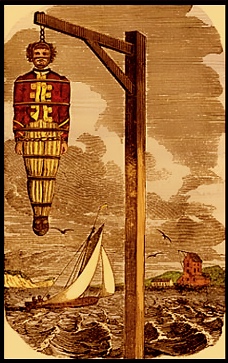 |
 |
|
The 17th Century British Privateer
and Legendary Pirate
Celebrated in English Literature as one of the
'Most Colorful Outlaws of all Time'
Only a select handful of Pirates are as
famous as Captain Kidd
These Include: Blackbeard and "Black Bart" Roberts
'Fortune Seekers' have hunted his Buried Treasure for Centuries |
|
Captain Kidd. . . by Howard Pyle |
Captain Kidd. . . by Helen Maitland Armstrong |
Captain William Kidd (1645-1701) was born in Greenock,
Scotland, a busy seaport. Some accounts claim his father was a minister,
but others claim he too was a seaman, who eventually became lost at sea.
Captain Kidd knew the West Indies. In his early youth Captain Kidd was a
member of various Buccaneer crews and eventually captained a
Privateer ship that was commissioned to protect the English colonies
in the Caribbean against French attacks.
For the English, sailing was very dangerous at the time. England was at
war with France, and piracy was common. Piracy in this age was a murky
affair. While countries hired Privateers like Captain Kidd to protect
their investments, it was also understood that these same privateers
could reap the bounty from the loot confiscated by enemy ships. This was
the age in which Captain Kidd cut his teeth as a young sailor. It was an
age that was coming to a close. |
|
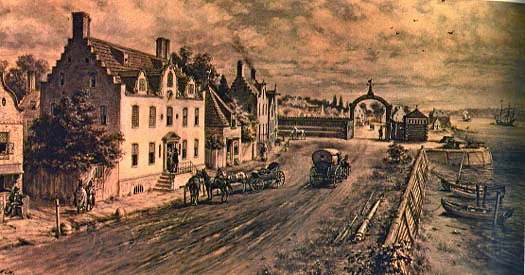 |
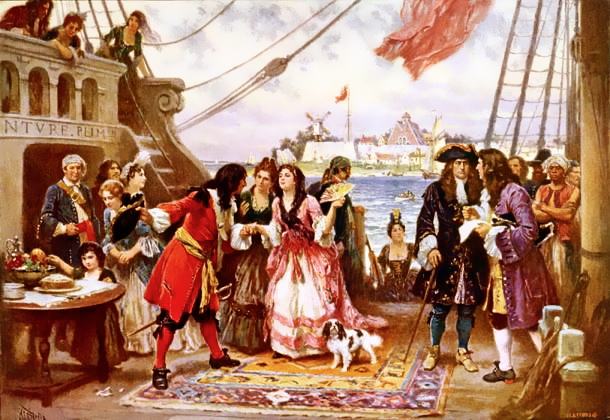 |
|
Captain Kidd's Brick House - Pearl &
Hanover Streets in New York City |
Captain Kidd in New York Harbor. . .
by Jean Leon Ferris |
| In 1689, sailing as a Privateer, he took a French vessel. The
ship was re-named the "Blessed William" and Captain Kidd was put
in command by the Governor of Nevis. He sailed into New York just in
time to save the governor there from a conspiracy. While in New York, he
married a wealthy widow. Not long after, in England, he became friends
with the Lord of Bellomont, who was to be the new Governor of New York. |
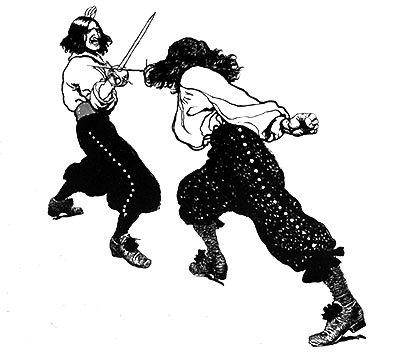 |
Marauding Pirates were constantly disrupting English shipping
traffic. To solve this problem it was decided that Captain Kidd would
sail to pirate infested waters and take pirates into custody. Captain
Kidd would then "recover" the booty the captured pirates had plundered
from other ships, and would divide it among himself and several
investors, who would include King William of England.
King William would enthusiastically support this plan, because the
Pirates were cutting off England's shipping and because he would receive
a cut of the profits. The key, Captain Kidd knew, was to leave untouched
English ships, and to prey only on those of other countries;
particularly Portugal, France, and Spain. Under this scheme, they could
continue to enjoy a life of Piracy while remaining protected by the
official sponsorship of the King of England.
Captain Kidd was given the 34-gun ship "Adventure Galley" and he
set out in May of 1696. A Privateer, his job was to catch other Pirates,
namely Captain Thomas Tew, John Ireland, Thomas Wake, and Milliam Mze/Mace.
Captain Kidd set sail for Madagascar and the Indian Ocean, then a hotbed
of Pirate activity. |
| Captain Kidd and his crew sailed continuously, scarcely ever putting
in to port for repairs, and eventually the Adventure Galley was close to
sinking. Too worn to be of any further use, the pirate ship was run
aground. Captain Kidd transferred his booty and possessions to the
Quedagh Merchant, which he had captured. |
|
Captain Kidd - Burying Treasure |
The "Adventure Prize" |
January 30th, 1698, Captain Kidd came across the Quedah
Merchant, Moorish ship, who's cargo was silk, calico, sugar, opium,
and iron. The ship was in Bengal, and its captain was John Wright an
Englishman. The Quedah Merchant was owned by an Armenian and its cargo
was to be shipped to a senior official at the court of the Mogul of
India. Of course the British owned the East Indian Company, and were
trying to keep India as friends for their commerce.
The holds of the Adventure Galley were already full when Captain Kidd
decided to plunder the Quedagh Merchant. The Quedagh Merchant was a huge
treasure ship of 400 tons (the Adventure Galley weighed only 284 tons).
As the Pirates approached the merchant, the captain of the vessel gave
the sign of surrender; however, the captain of the merchant was secretly
preparing for battle.
Sails were trimmed, sand was poured for better footing, ammunition was
readied, and buckets were filled for fire fighting. As the pirates
neared, the merchant vessel fired, but due to a sudden ocean swell, the
shot missed its mark. The Pirates immediately threw their grappling
hooks, bringing the two ships together. The Pirates rapidly boarded the
ship, and soon Captain Kidd was in the possession of one of the greatest
pirate treasures ever, and renamed her the "Adventure Prize". |
|
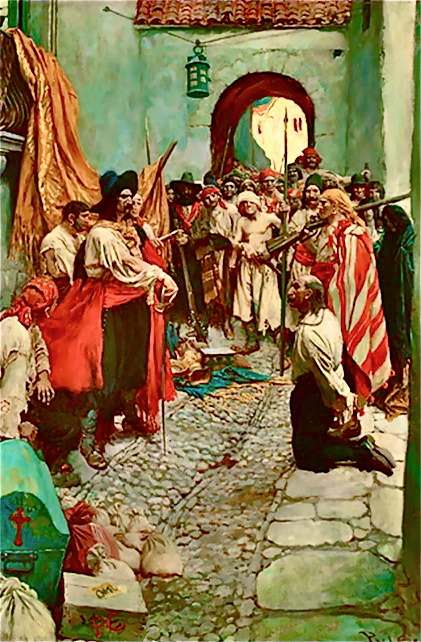 |
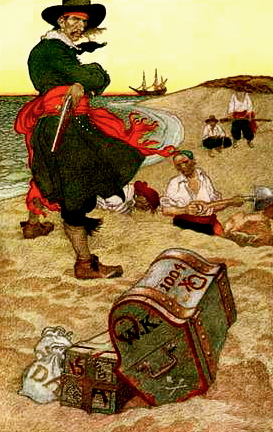 |
Captain Kidd was arrested upon his return to New York by the former
sponsor of his privateering enterprise, Governor Lord Bellomont. He was
taken back to England and put in the notorious Newgate Prison in London,
to await his trial. The trial was held on the 8th and 9th of May, 1701.
Captain Kidd was found guilty at Old Bailey, London, England.
Captain Kidd was hanged on May 23rd, 1701 at Tilbury Point
(Execution Dock). Following tradition the crowds passed him rum and
Captain Kidd was blind drunk when he swung from the gallows.
It was said that Captain Kidd died hard, as the rope broke from his
weight and he fell to the ground. He was tied up a second time, rehung,
and died. This is why there is a legend of Captain Kidd being hung
twice. After he was dead, his body was put in a harness of iron hoops (a
gibbet) and chains so that all mariners could observe his rotting,
crow-pecked corpse for more than an hour, as they swept around that wide
and desolate part of the Thames River. This was a warning to other
seamen regarding what happens to Pirates. Captain Kidd was tarred so as
to hold the skeleton together longer, thus his body was totally
blackened. |
|
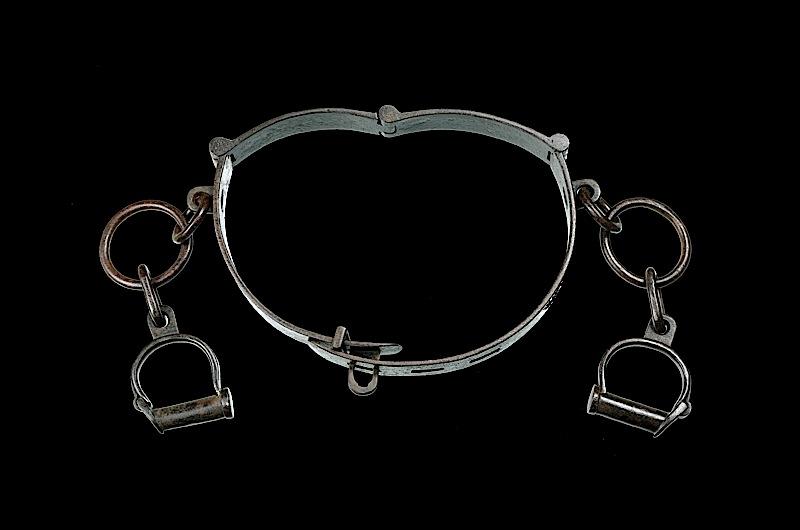 |
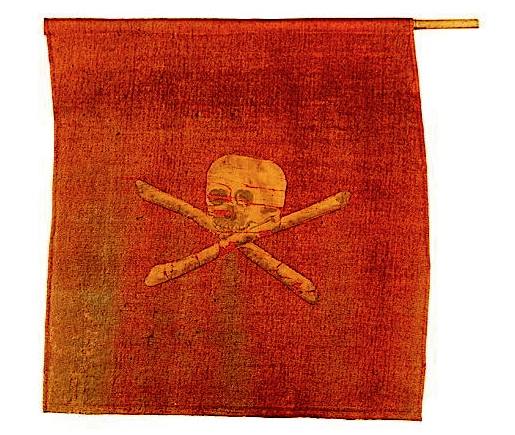 |
|
Newgate Prison Manacles |
Captain Kidd's Flag |
|
Captain Kidd's Treasure |
Legendary Pieces of Eight |
|
50kg Silver Bar Found in Madagascar
Treasure of Captain Kidd? |
| Underwater explorers in Madagascar have made an incredible
discovery. It is a 50 kg block of silver with inscriptions. It is now
under armed guard on Sainte Marie Island off the east coast of
Madagascar. The valuable treasure may be from the wreckage of a pirate
ship belonging to the notorious Scottish Pirate William Kidd. |
|
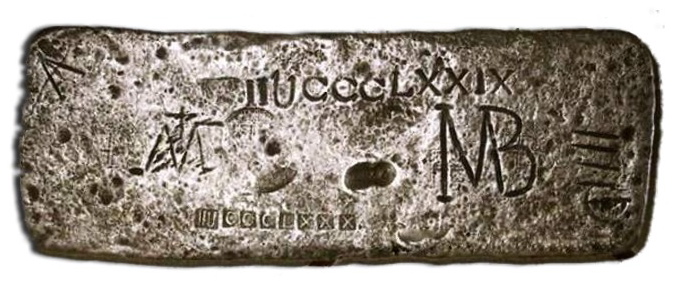 |
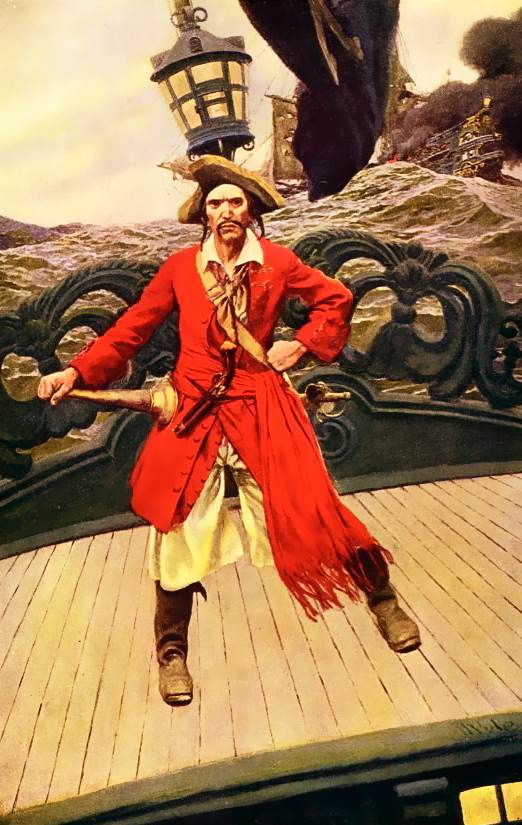 |
The silver bar was found in shallow waters off Sainte
Marie Island by an underwater investigator who discovered the remains of
Captain Kidd’s ship the 'Adventure Galley' fifteen years ago.
The bar is imprinted with letters and numbers the meaning of which is
currently unknown.
The silver bar, which was presented to the President of Madagascar in a
special ceremony on Sainte Marie Island, is believed to have its origins
in Bolivia, while the ship is thought to have been built in England.
Work will now be carried out to verify the origin of the treasure.
There is much excitement in Madagascar about the discovery and no doubt
that the discovery is genuine.
.jpg)
Captain William Kidd was tried and executed for Piracy after
returning from a voyage to the Indian Ocean. He is typically perceived
as either one of the most notorious pirates in history, or as one of its
most unjustly vilified and persecuted Privateers. |
| The latter view comes from the fact that his actions were allegedly
less destructive and less lucrative than other Pirates, yet he met a
rather brutal end, as he was hanged twice before being covered in tar
and hung from a gibbet over the river Thames. |
| William Kidd was a Buccaneer and a captain commissioned to
sail to Madagascar on his ship the Adventure Galley. |
When Captain Kidd learned that he was a wanted pirate, he deposited
some of his treasure on Gardiners Island, hoping to use his knowledge of
its location as a bargaining tool. A small cache of Captain Kidd’s
treasure was eventually recovered from Gardiners Island in a spot known
as Cherry Tree Field, however it was sent to England to be used as
evidence against him.
Captain Kidd was captured in Boston in 1699 and sent to Newgate Prison.
The treasure found on his ship was valued at £30,000 (around £10 million
today), but the remainder of his treasure was never found.
The belief that Captain Kidd had left buried treasure contributed considerably
to the growth of his legend and has also given impetus to constant
treasure hunts in places Captain Kidd is known to have visited.
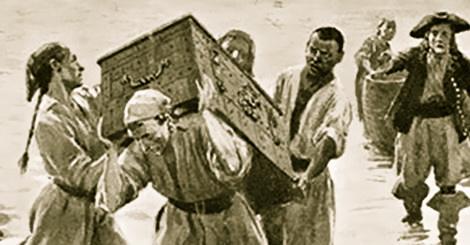 |
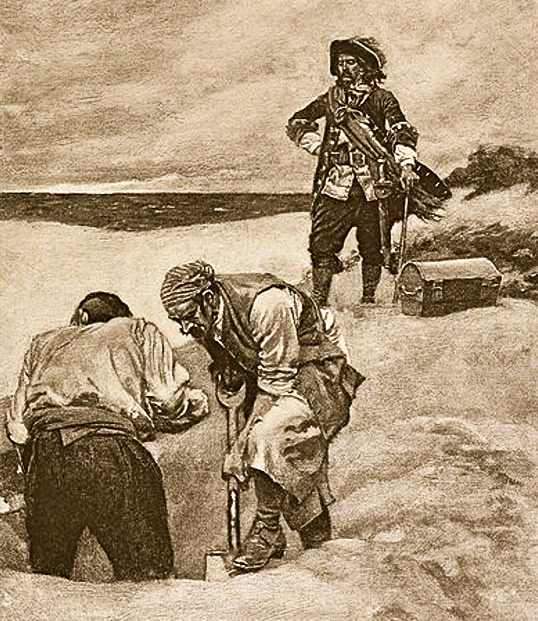 |
|
Captain William Kidd - Supervision
of the Burial of Treasure at Gardiner's Island |
|
"Captain Kidd" is Today a Facet of the
Popular Culture |
|
Frenchman Captain Olivier Levasseur
Born 1680 - Died 1730 by Execution |
|
On July 7th, 1730
Pirate Olivier Levasseur was Hanged at Reunion
Island
Legendarily Hurling into the Crowd Cryptic Directions to his Vast
Hidden Treasure |
|
“My treasure is buried here . . .
find it who may.” |
| These were the dramatic words shouted out to the crowd gathered
around the foot of the gallows on the Isle de Bourbon, known today as
Reunion Island, as the noose tightened around the neck of a notorious
French pirate. He was Oliver Levasseur, nick-named La Buzze (the
Buzzard). |
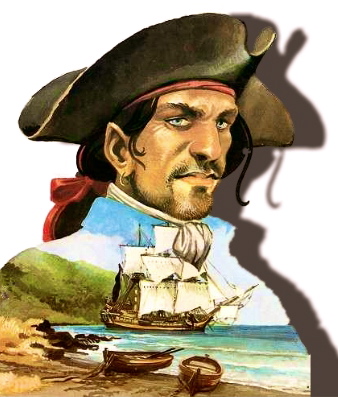 |
A bourgeois son of Calais France, Levasseur made his start as a
French naval officer turned Privateer during the "War of Spanish
Succession". Later transitioning to fulltime Buccaneer after that
conflict ended in 1714.
By the 1720s, Levasseur commanded a mixed-race crew, raiding across the
east African Coast and the Indian Ocean.
Descending upon the Portuguese Galleon "The Virgen of Goa"; fat with
gems, gold bars and loose guineas, silks, a gigantic decorative cross,
and a noble’s diamond encrusted sword, Levasseur’s crew was able to
plunder a vast fortune, equal to a sum of around a billion dollars in
today's currency.
This stupendous fortune, even after dividing it with the crew, would
cinch Levasseur’s fame, and his fate. For the Pirates were later
disarmed at anchor off Reunion Island after having barely survived a
great storm.The reason we’re still talking about Levasseur three
centuries on is that he’s alleged, just before was hung, to have hurled
a bundle of parchments and/or a cryptogram necklace into the crowd
assembled to watch him die, crying “find my treasure, who can!” or “my
treasure for he who understands!” And that’s pretty tantalizing stuff,
considering the treasure has never since been found.
Levasseur’s treasure is thought to be stashed somewhere on the
Seychelles Island of Mahe. The slow and tantalizing unraveling of the
Pirate's mysterious clues have seduced generations of treasure hunters. |
|
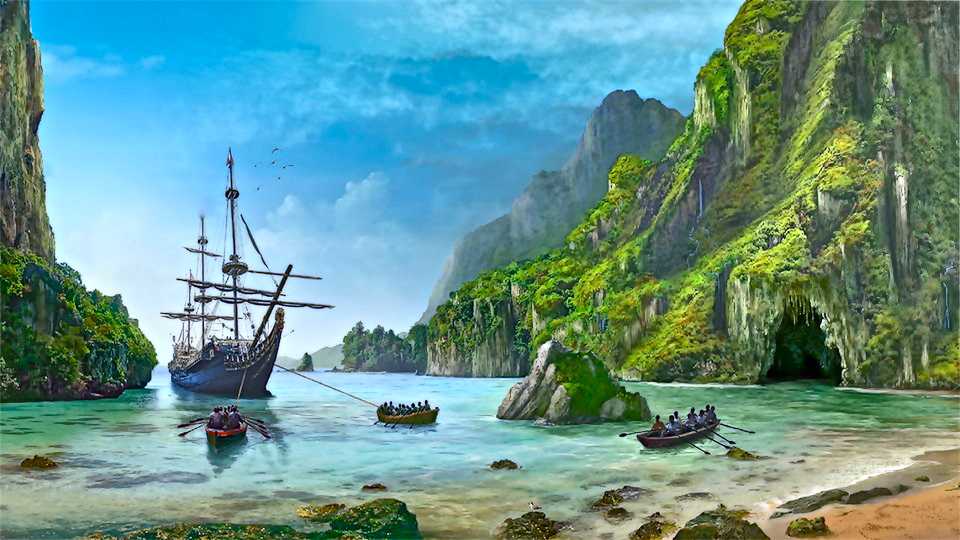 |
| Captain Levasseur is today only a minor cinematic figure. Basil
Rathbone portrayed him loosely in a 1935 Errol Flynn movie. In 'Captain
Blood', Rathbone (Levasseur) dies by Flynn’s hand in a swordfight. |
|
"Captain Blood" Pirate Duel - Basil Rathbone as
Levasseur (right) |
Movie Poster - 1935 |
|
"... let's jump on
Board and cut them to pieces" (Battle cry of Edward "Blackbeard"
Teach) |
|
Blackbeard's
"Queen Anne's Revenge"
Wreck Found
Blackbeard's ship, Queen Anne's Revenge, now being
explored by marine archeologists off the coast of North Carolina, is
giving up more than just its treasures, it's also revealing the infamous
pirate's terrifying tactics. And what researchers are finding are an
ingenious array of improvised weapons, designed to injure and
incapacitate as many people as possible, while leaving ships and their
valuable cargo intact. The wreckage has yielded
cannon that fired canvas bags filled with glass, nails, and spikes, or
batches of nine-inch bolts—devastating to humans, but not so much to
ships.
"These weapons would terrorize the enemy," said the expedition's leader.
“This vessel is heavily armed but the crew are not using that many
cannonballs. Mostly, they seem to have used these improvised missiles
that can be used to take out the crew or disarm the other ship’s sails."
But more than just maiming people, Blackbeard's goal appears to have
been to win without fighting at all. "Their aim was to capture a ship by
intimidation and leave it in pristine condition," said one expert. "They
didn’t want to damage the ship or its cargo." |
| He was a real-life pirate of the Caribbean, who carefully cultivated
a bloodthirsty reputation that struck fear through seafarers. Now,
almost 300 years after Blackbeard's death, marine archaeologists have
discovered a huge anchor and an arsenal of "improvised" ammunition from
the wreck of his flagship,
Queen Anne’s Revenge. The ship ran
aground on a sandbank about a mile from shore on June 10 1718, as
Blackbeard’s flotilla of four vessels was heading for Beaufort Inlet, in
the then British colony of North Carolina.
The shipwreck lies in about 25ft of water just off the coast of the
state of North Carolina and the expedition to recover artifacts is being
led by the state’s Department of Cultural Resources.
The leader of the expedition and deputy state archaeologist, Dr Mark
Wilde-Ramsing, said: “This vessel is heavily armed but the crew are not
using that many cannonballs. Mostly, they seem to have used these
improvised missiles that can be used to take out the crew or disarm the
other ship’s sails. |
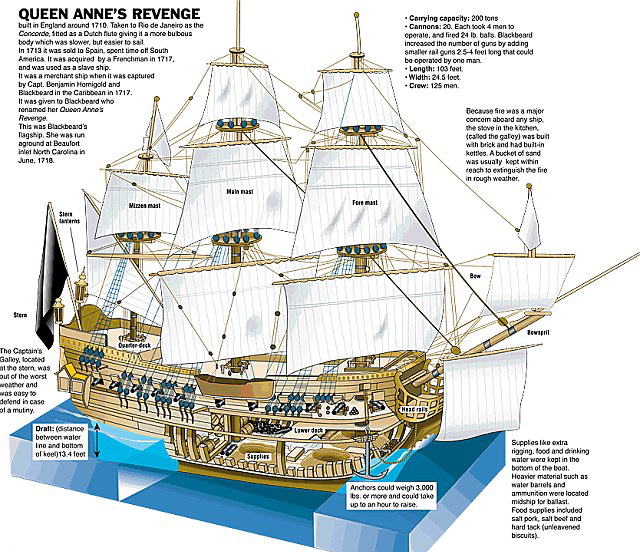 |
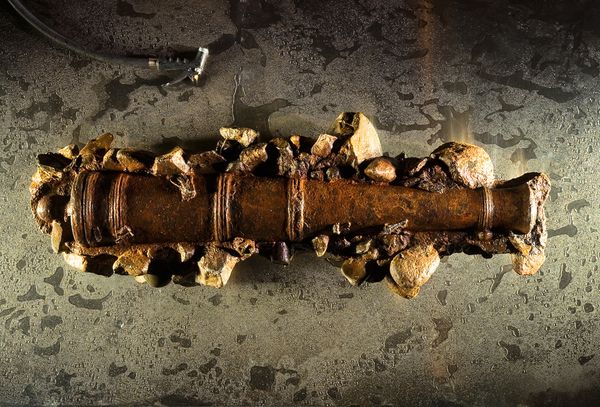 |
“These weapons would terrorize the enemy. It is all part of
Blackbeard’s terror tactics. It has been claimed that he deliberately
cultivated a fearsome reputation so enemy sailors would not put up a
fight, allowing him to seize vessels without the need for violence. On
earlier dives, the researchers have found evidence of a range of
“makeshift” devices, such as canvas bags filled with a lethal mass of
lead shot, nails, spikes and glass and then fired from the cannon,
pouring a deadly hail of projectiles onto opponents. This type of
bundled ammunition was known as “langrage” and was not used by Royal
Navy ships, according to 18th-century documents.
The ship’s unusual arsenal already identified also includes nine-inch
bolts, which were pushed down in the barrels of cannons and would by
fired out by a cannonball loaded behind them, as well as “double-headed”
cannonballs – where two are linked together by a bar or chain – and
which produced a spinning effect when fired from
cannon and were
effective at bringing down rigging. |
Angus Konstam, author of Piracy: The Complete History, said: “The
improvised charges show a lot of ingenuity on the part of the pirates.
These would have been anti-personal charges. They wouldn’t do much
damage to a ship but would do a lot of damage to people in it. Their aim
was to capture a ship by intimidation and leave it in pristine
condition. They didn’t want to damage the ship or its cargo.”
Blackbeard is believed to have been born Edward Teach, or Edward Thatch,
in Bristol, in 1680. He fought as a privateer for the British, attacking
Spanish and French ships in the War of the Spanish Succession, before
turning to piracy. His troop captured a French slave ship called La
Concorde near the Caribbean island of St Vincent in November 1717 and
renamed it Queen Anne’s Revenge. It became his flagship, sailing
alongside three smaller sloops.
Blackbeard’s striking appearance and character has inspired many
subsequent depictions of pirates. He is said to have had 14 wives, and
would tie burning fuses into his long beard before battle to give
himself a demonic appearance. His flag depicted a skeleton spearing a
heart while toasting the devil. |
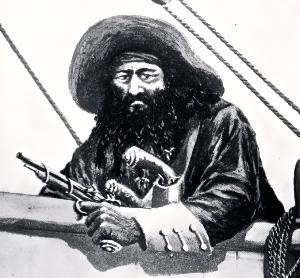 |
After the loss of his flagship, Blackbeard sought and was granted a
pardon. But he continued to seize ships, and the Royal Navy were sent to
track him down. He was killed in a battle in November 1718, after which
his head was cut off and his body tossed overboard.
According to legend, his headless corpse swam around his ship five times
before he finally died. His head was attached to the bowsprit of a Navy
ship and his skull was later used as a punch bowl. |
|
To keep his ship going
Blackbeard had to have a healthy, functioning crew |
|
Recently unearthed from the
wreckage various medical devices
Some of them looking terrifying |
| Thanks to the medical artifacts found aboard the flagship,
we are learning more about how Blackbeard's crew treated not
only small wounds and ailments, but also chronic illnesses. They
were seeking relief for any kind of ailment, and certainly if
there was warfare on the water, there were wounds among other
injuries that needed treatment. |
|
A Urethral Syringe used to
Treat Syphilis
Ship 'Queen Anne's Revenge' |
Various Sized Cups to
Measure Medicine
Ship 'Queen Anne's Revenge' |
|
A Mortar and Pestle - Used to Grind
Ingredients to Make Medicine |
In the end, Blackbeard's efforts to keep up his crew's
health didn't change the pirate's own fate when he was hunted
down in November 1718 by the Royal Navy.
Blackbeard was in good enough shape that he is said to have put
up a terrific final fight while trying to board an enemy ship.
"He stood his ground and fought with great fury, till he
received five and 20 wounds, and five of them by shot," Johnson
wrote. "At length, as he was cocking another pistol, having
fired several before, he fell down dead." |
|

